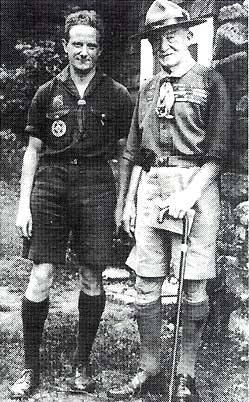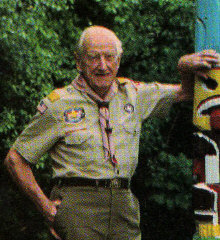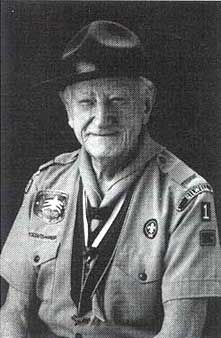William Hillcourt facts for kids
Quick facts for kids
William Hillcourt
|
|
|---|---|

Hillcourt (L) and Lord Robert Baden-Powell (R), at Hillcourt Cottage, Schiff Scout Reservation, on July 15, 1935
|
|
| Born |
Vilhelm Hans Bjerregaard Jensen
August 6, 1900 Aarhus, Denmark
|
| Died | November 9, 1992 (aged 92) Stockholm, Sweden
|
| Resting place | St. Joseph's Cemetery, Mendham, New Jersey, United States |
| Nationality | Danish, American |
| Occupation | Scouter |
| Employer | Boy Scouts of America |
| Known for | First U.S. Wood Badge course director, author including Boy Scout Handbook, Boy Scout Fieldbook, Patrol Leaders Handbook, and articles for Boys' Life and Scouting magazines. |
| Spouse(s) | Grace Brown |
| Parent(s) | Johannes Hans Bjerregaard Jensen Andrea Christine (nee Pedersen) |
| Awards | Knight-Scout, Denmark (1918) Distinguished Eagle Scout Award (1978) Silver Buffalo Award (1980) Bronze Wolf Award (1985) |
| Signature | |
 |
|
William Hillcourt (born August 6, 1900 – died November 9, 1992) was a very important leader in the Boy Scouts of America (BSA). Many people in the Scouting movement knew him as "Green Bar Bill". He was active in Scouting from 1927 until his death in 1992.
Hillcourt was a great writer and teacher. He taught about outdoor skills, how Scout troops and patrols should be set up, and how to train leaders. He wrote three versions of the BSA's official Boy Scout Handbook, with over 12.6 million copies printed. He also wrote other Scouting books and many magazine articles. Hillcourt helped create and promote the American version of the Wood Badge program, which trains adult Scout leaders.
William Hillcourt was from Denmark. He moved to the United States when he was a young adult. He started in Danish Scouting in 1910 and stayed involved until he passed away in 1992. He traveled all over the world, teaching and training both Scouts and Scout leaders. He earned many of Scouting's highest awards. His ideas and influence are still seen today in the BSA program and in Scouting training for both young people and adults.
Contents
William Hillcourt's Early Life and Family
Hillcourt was born in 1900 in Aarhus, Denmark. He was the youngest of three sons. His father was a building contractor. His birth name was Vilhelm Hans Bjerregaard Jensen. Around 1930, he changed his name to William Hillcourt. He changed "Vilhelm" to "William" and translated "Bjerregaard" into "Hill-court." He dropped "Jensen."
When he was nine years old, a newspaper in Aarhus printed his first published work, a poem about trolls and elves. For Christmas in 1910, Hillcourt's brother gave him a Danish translation of Scouting for Boys. This book was written by Baden-Powell, who founded the Scout movement.
Hillcourt earned the highest award in Danish Scouting, called Knight-Scout, in 1918 when he was 17. In 1920, he was chosen to represent his troop at the 1st World Scout Jamboree in Olympia, England. There, he met Baden-Powell for the first time. They would later work together.
While studying pharmacy in Copenhagen, Hillcourt became even more involved in Scouting. He became a Scoutmaster, a national instructor, a writer, and then the editor for the Danish Scouting journal. He wrote his first book, The Island, which shared his early Scouting adventures.
Becoming a Leader in American Scouting
Hillcourt wanted to experience Scouting around the world. He hoped to bring the best ideas back home. He traveled through Europe and England, arriving in the United States in February 1926. Soon after, the BSA's national office hired him. He worked for the BSA until he retired in 1965. In 1933, Hillcourt married Grace Brown, who was the personal secretary to Chief Scout Executive James E. West.
In 1926, Hillcourt worked at a BSA camp in Harriman State Park, New York. There, he taught American Indian dance. Later, he worked for the BSA Supply Division. He met James West in an elevator at the national office. West asked Hillcourt for his thoughts on Scouting in the U.S. Hillcourt later sent West an 18-page memo. It explained problems with the lack of patrol structure and leadership. He suggested that the BSA write a handbook for patrol leaders. He also said it should be written by someone who had been both a patrol leader and a Scoutmaster. West hired Hillcourt as a writer and editor. Later, West asked Hillcourt to write the first Handbook for Patrol Leaders, which came out in 1929.

From 1932 until his retirement in 1965, Hillcourt wrote a lot for Boys' Life. This magazine is for young Scouts. Each month, he wrote a page about earning badges and Scoutcraft, which are outdoor Scouting skills. His signature was placed over the two green bars that are the symbol of a patrol leader. This is how he got his nickname "Green Bar Bill." This name became the logo for his regular column in Boys' Life.
In 1934, Hillcourt was asked to write a new manual for Scoutmasters. He worked with his good friend E. Urner Goodman, who was the national program director of the BSA. Hillcourt and his wife moved to a house in Mendham Borough, New Jersey. This was close to Schiff Scout Reservation, the BSA's national training center. This way, he could test his ideas in real life. To do this, he started Troop 1 of Mendham in 1935. This troop was directly connected to the National Council of the BSA. As the Scoutmaster, he used Troop 1 for 16 years to test and prove his work.
The Baden-Powells visited Schiff in 1935. They became close friends with the Hillcourts. Baden-Powell passed away in 1941. After World War II, Baden-Powell's wife, Olave Baden-Powell, allowed Hillcourt to edit Aids to Scoutmastership. He turned it into the World Brotherhood Editions to help Scouting recover after the war. She then let Hillcourt see Baden-Powell's letters, diaries, and sketchbooks. She and Hillcourt then wrote a book together about Baden-Powell's life, called Baden-Powell: The Two Lives of a Hero.
In 1954, the BSA national office moved from New York City to North Brunswick, New Jersey. The Hillcourts moved with it. He finished the sixth edition of the Boy Scout Handbook in time for the BSA's 50th anniversary in 1960.
William Hillcourt and Wood Badge Training
J. S. Wilson traveled from the UK to the U.S. in May 1936. He came to lead a Wood Badge course at Schiff. This was done to help start Rovering in the U.S. Hillcourt was part of that first course. Four days later, he was the senior patrol leader for the second course. He received his Wood Badge beads in 1939. He was then named the deputy camp director for Wood Badge.
After World War II, Wood Badge started up again. Hillcourt was the Scoutmaster for a test course that began on July 31, 1948, at Schiff. He also led the first regular course at Philmont Scout Ranch. As the national director of training, Hillcourt wore five Wood Badge beads. This tradition has stopped in the U.K. Scout Association. However, other countries still use five Wood Badge Beads. They are worn by the National Volunteer Leader of Wood Badge Training in each country. They can also be worn by special permission from Gilwell Park today.
Later Years and Lasting Impact
Hillcourt retired from the BSA on August 1, 1965. In 1971, he and Grace finally finished the world tour he had started in 1926. During their trip, they went to the 13th World Scout Jamboree in Fujinomiya, Japan. Grace Hillcourt passed away in 1973. Instead of living alone, Bill moved in with his good friends Carson and Martha Buck.
In 1972, the BSA introduced the "Improved Scouting Program." This came with a new Boy Scout Handbook. Many of the changes were meant to include more young people and make Scouting more "modern." Many Scout leaders, including Hillcourt, did not like the new program. They felt that taking away the focus on traditional outdoor skills took the "outing out of Scouting." This change did not work well. It made existing Scouts less interested and did not attract many new ones.
To fix this, Hillcourt convinced Chief Scout Executive Harvey L. Price that a new handbook was needed. Hillcourt then came out of retirement. He spent a year writing and editing the 1979 edition of The Official Boy Scout Handbook. This book brought back the focus on Scoutcraft. He also helped create the All Out for Scouting program. This program brought back the older Scouting standards. Hillcourt was seen as a very important person who helped the BSA recover from its experiment in the 1970s.
Hillcourt was honored for his service to young people by the BSA. He received the Distinguished Eagle Scout Award on May 19, 1978. In 1980, the BSA gave Hillcourt their highest national honor, the Silver Buffalo Award. He was called "The Voice of Scouting." In 1985, the World Scout Committee of the World Organization of the Scout Movement recognized him. They gave him the Bronze Wolf Award for his amazing service to world Scouting. In the same year, an article in Scouting magazine said Hillcourt was "the most important influence on the development of the Boy Scouting program."
In 1985, he traveled to many cities like Dallas, Washington, and Los Angeles. He also went to the World Conference in Germany. He attended an inter-American scout conference in Brazil. He also visited Argentina and Paraguay. He served as a Scoutmaster in the Wood Badge program for leaders in South America. He ended his trip in Caracas, Venezuela. He was also a Troop Head and Director of the Field-School "Paramacay."
In August 1985, he celebrated his 85th birthday with old friends in Copenhagen, Denmark. He continued to attend different Scouting events and always made an appearance. He kept his record of attending every Jamboree. In 1990, he became a member of Firecrafter, an American Scouting service organization. Traveling and appearing at Scouting events, both local and worldwide, were part of his life until he died. Because of this, he was called Scoutmaster to the World.
Hillcourt passed away at age 92 in Stockholm, Sweden, on November 9, 1992. He was traveling on a Scouting tour with Carson Buck. He is buried with his wife Grace in St. Joseph's Cemetery in Mendham Borough, New Jersey, United States. His grave is near Schiff Scout Reservation, where he lived for many years. His legacy and influence continue in Scouting programs and training. His writings are still used and reprinted in Scouting magazine. The Longhouse Council runs the William Hillcourt Scout Museum and Carson Buck Memorial Library in New York. Its goal is to "keep the traditions of Scouting alive" by preserving its history.
William Hillcourt's Books and Articles
Hillcourt was one of the BSA's most active writers. He wrote many articles for Boys' Life and Scouting magazines. He had a column for patrol leaders called "Patrol Leader Green Bar Bill." More than 12.6 million copies of his three editions of the Boy Scout Handbook were printed.
Here are some of his important works:
- (1925) The Island
- (1929) Handbook for Patrol Leaders
- (1933) The 1933 Scout Jamboree Book with James E. West
- (1936) Handbook for Scoutmasters, Third edition in two volumes
- (1946) Aids to Scoutmastership, World Brotherhood Edition, by Baden-Powell, revised by Hillcourt
- (1946) Scouting for Boys, World Brotherhood Edition, by Baden-Powell, revised by Hillcourt
- (1948) Scout Fieldbook, First edition, with West
- (1950) Handbook for Patrol Leaders; World Brotherhood Edition
- (1959) Boy Scout Handbook, Sixth edition
- (1961) Field Book of Nature Activities and Conservation: An Indispensable Guide for Nature Lovers
- (1964) Baden-Powell: The Two Lives of a Hero; biography of Baden-Powell
- (1965) Boy Scout Handbook, Seventh edition
- (1967) Handbook for Patrol Leaders, Second edition (heavily edited revision)
- (1967) Physical Fitness for Boys
- (1967) Physical Fitness for Girls
- (1968) Your Guide to Fitness
- (1970) New Field Book of Nature Activities & Hobbies
- (1970) Fun With Nature Hobbies
- (1971) The Golden Book of Camping
- (1975) Outdoor Things To Do: Year-round Nature Fun for Girls and Boys
- (1977) Norman Rockwell's World of Scouting; biography of iconic illustrator Norman Rockwell
- (1979) The Official Boy Scout Handbook, Ninth edition
- (1980) The Official Patrol Leader Handbook, Third edition
Images for kids
See also
- Scouting memorials



